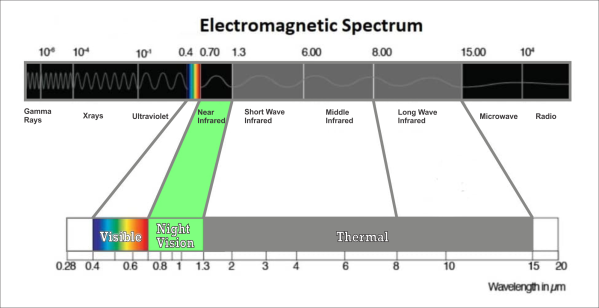

How Does IR Magic Black Work?

Question: Does IR Magic Black work with thermal imagers? The short answer is NO,
IR Magic Black works in Near-Infrared with Night Vision Equipment.
What is unique about NIR Cameras and Night Vision equipment? “Near-infrared” (NIR) is the portion of the electromagnetic spectrum directly adjacent to the visible range; therefore it cannot be perceived with the human eye. Near Infrared (NIR) is a subset of the infrared band of the electromagnetic spectrum, covering the wavelengths ranging from 0.7 to 1.4 microns. This wavelength is just outside the range of what humans can see and can sometimes
offer clearer details than what is achievable with visible light imaging.
NIR is very close to human vision but removes the color wavelengths, which results in most objects looking very similar to an image that has been converted to black and white. One exception is trees and plants, which are highly reflective in the NIR wavelength and thus appear much brighter than they do in color. That difference in reflectivity of certain objects, in combination with reduced atmospheric haze and distortion in the NIR wavelength, means that detail and visibility are often improved at long ranges.
See Through Haze & Smoke- The longer wavelengths of the NIR spectrum are able to penetrate haze, light fog, smoke and other atmospheric conditions better than visible light. For long-distance imaging, this often results in a sharper, less distorted image with better contrast than what can be seen with visible light.
Effective for Identification- Unlike thermal energy which displays objects quite differently from visual perception, NIR is a reflected energy that behaves similar to visible light, which means that it can see things like printed information on signs, vehicles and vessels that thermal imaging usually cannot. Faces, clothing and many other objects will also look more natural and recognizable than they do with thermal imagers.
IR Magic Black is transparent in Near Infrared 700-1,400 Nanometers.
Best used with Night Vision equipment and Cameras.
Thermal imagers are altogether different. In fact, we call them “cameras” but they are really sensors. To understand how they work, the first thing you have to do is forget everything you thought you knew about how cameras make pictures.
FLIRs (or thermal imagers) make pictures from heat, not visible light. Heat (also called infrared, or thermal, energy) and light are both parts of the electromagnetic spectrum, but a camera that can detect visible light won’t see thermal energy, and vice versa.
Thermal imagers work between 9,000-14,00 Nanometers,
Infrared Magic Black does not give off a heat signature and therefore does not give any reaction to thermal imagers.